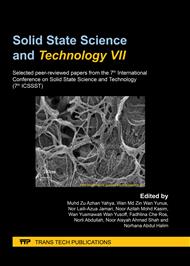[1]
H. Yuan, J. Luan, Z. Yang, J. Zhang, Y. Wu, Z. Lu, H. Liu, Single lithium-ion conducting solid polymer electrolyte with superior electrochemical stability and interfacial compatibility for solid-state lithium metal batteries, ACS Applied Materials & Interfaces 12 (2020) 7249–7256.
DOI: 10.1021/acsami.9b20436
Google Scholar
[2]
N. Boaretto, L. Meabe, M. Martinez-Ibañez, M. Armand, H. Zhang, Review—polymer electrolytes for rechargeable batteries: from nanocomposite to nanohybrid, Journal of The Electrochemical Society 167 (2020) 070524.
DOI: 10.1149/1945-7111/ab7221
Google Scholar
[3]
L. Edman, M.M. Doeff, A. Ferry, J. Kerr, L.C. Jonghe, Transport properties of the solid polymer electrolyte system P(EO)nLiTFSI, J. Phys. Chem. B 104 (2000) 3476–3480.
DOI: 10.1021/jp993897z
Google Scholar
[4]
Y. Jiang, X. Yan, Z. Ma, P. Mei, W. Xiao, Q. You, Y. Zhang, Development of the PEO based solid polymer electrolytes for all-solid state lithium ion batteries, Polymers 10 (2018) 1237.
DOI: 10.3390/polym10111237
Google Scholar
[5]
B.L. Rivas, E.D. Pereira, I.M. Villoslada, Water-soluble polymer-metal ion interactions, Prog. Polym. Sci. 28 (2003) 173–208.
Google Scholar
[6]
S.B. Aziz, T.J. Woo, M.F.Z. Kadir, H.M. Ahmed, A conceptual review on polymer electrolytes and ion transport model, Journal of Science: Advanced Materials and Devices 3 (2018) 1–17.
DOI: 10.1016/j.jsamd.2018.01.002
Google Scholar
[7]
E.A. Baroncini, D.M. Rousseau, C.A. Strekis, J.F. Stanzione, Optimizing conductivity and cationic transport in crosslinked solid polymer electrolytes, Solid State Ionics 345 (2020) 115161.
DOI: 10.1016/j.ssi.2019.115161
Google Scholar
[8]
N.K. Jaafar, S.Z.Z. Abidin, A.M.M. Ali, A. Saat, M.Z.A. Yahya, The effects of ceramic fillers on chitosan grafted PMMA based polymer electrolyte, AIP Conference Proceedings 2030 (2018) 020061.
DOI: 10.1063/1.5066702
Google Scholar
[9]
P.V. Wright, Electrical conductivity in ionic complexes of poly (ethylene oxide), Polymer Journal 7 (1975) 319–324.
Google Scholar
[10]
M.L. Verma, H.D. Sahu, Study on ionic conductivity and dielectric properties of PEO-based solid nanocomposite polymer electrolytes, Ionics 23 (2017) 2339–2350.
DOI: 10.1007/s11581-017-2063-4
Google Scholar
[11]
S.S. Sekhon, N. Arora, H.P.S. Missan, Effect of donor number of solvent on the conductivity behaviour of nonaqueous proton-conducting polymer gel electrolytes, Solid State Ionics 160 (2003) 301–307.
DOI: 10.1016/s0167-2738(03)00167-x
Google Scholar
[12]
H. Ericson, C. Svanberg, A. Brodin, A. M. Grillone, S. Panero, B. Scrosati, Poly(methyl methacrylate)–based protonic gel electrolytes: A spectroscopic study, Electrochim. Acta 45 (2000) 1409–1414.
DOI: 10.1016/s0013-4686(99)00352-7
Google Scholar
[13]
S. Gupta, P.K. Varshney, Effect of plasticizer on the conductivity of carboxymethyl cellulose-based solid polymer electrolyte, Polymer Bulletin 76 (2019) 6169–6178.
DOI: 10.1007/s00289-019-02714-1
Google Scholar
[14]
A.M. Stephan, Review on gel polymer electrolytes for lithium batteries, European Polymer Journal 42 (2006) 21–42.
DOI: 10.1016/j.eurpolymj.2005.09.017
Google Scholar
[15]
S.V. Kuppu, A.R. Jeyaraman, P.K. Guruviah, Preparation and characterizations of PMMA–PVDF based polymer composite electrolyte materials for dye-sensitized solar cell, Current Applied Physics 18 (2018) 619–625.
DOI: 10.1016/j.cap.2018.03.014
Google Scholar
[16]
R. Wilson, S.C. George, A. Kumar, S. Thomas, Chapter 1-Liquid transport characteristics in polymeric systems: an introduction, in: S. Thomas, R. Wilson, A. Kumar, S.C. George, Transport Properties of Polymeric Membranes, Elsevier, 2018, p.3–13.
DOI: 10.1016/b978-0-12-809884-4.00001-x
Google Scholar
[17]
S.S. Sekhon, M. Kumar, Plasticized proton conducting polymer electrolytes based on poly(ethylene oxide) and ammonium salts NH4X: X = F-, BF4-, in: B.V.R Chowdari, Solid State Ionics–Trends in the New Millennium, World Scientific, 2002, p.337–384.
DOI: 10.1142/9789812776259_0042
Google Scholar
[18]
S. Selvalakshmi, T. Mathavan, S. Selvasekarapandian, M. Premalatha, Effect of ethylene carbonate plasticizer on agar-agar: NH4Br-based solid polymer electrolytes, Ionics 24 (2018) 2209–2217.
DOI: 10.1007/s11581-017-2417-y
Google Scholar
[19]
S.M.M. Razalli, S.I.Y.S.M. Saaid, T.I.T. Kudin, M.Z.A. Yahya, O.H. Hassan, A.M.M. Ali, Electrochemical properties of glyme based plasticizer on gel polymer electrolytes doped with lithium bis(trifluoromethanesulfonyl)imide, Materials Science Forum 846 (2016) 534–538.
DOI: 10.4028/www.scientific.net/msf.846.534
Google Scholar
[20]
K. Gohel, D.K. Kanchan, Effect of PC: DEC plasticizers on structural and electrical properties of PVDF–HFP:PMMA based gel polymer electrolyte system, Journal of Materials Science: Materials in Electronics 30 (2019) 12260–12268.
DOI: 10.1007/s10854-019-01585-6
Google Scholar


